About 5km from Tu Hieu Pagoda. Truong Tien Bridge or Trang Tien Bridge, is an iconic landmark of Hue. Spanning the Perfume River, this bridge has been a silent witness to the historical and cultural transformations of the city. Truong Tien, this architectural marvel serves as a vital connection between the city’s two riverbanks and symbolises Hue’s enduring legacy. With its elegant arches and picturesque setting, the bridge is a must-visit for anyone exploring the ancient capital.
What to know about Truong Tien Bridge
The bridge is renowned for its historical significance and aesthetic appeal. The bridge’s strategic location in the heart of Hue makes it easily accessible and a focal point for locals and tourists. Over the years, the bridge has undergone several name changes, each reflecting the political and cultural shifts of the times.
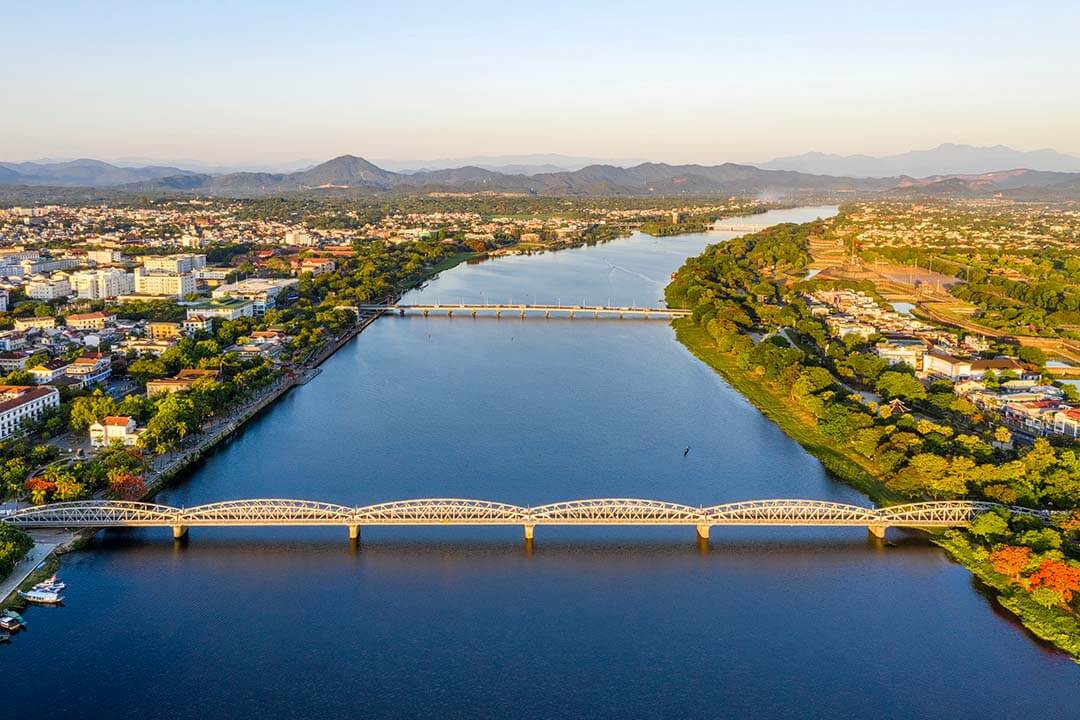
Immerse yourself in the bridge’s rich history
Truong Tien Bridge, a key symbol of Hue’s history, was first commissioned by King Thanh Thai in 1896, marking a significant milestone in the city’s modernisation efforts. Designed by Gustave Eiffel, the bridge was completed in 1899 and was initially named Thanh Thai Bridge in honour of the reigning king. However, its history is deeply intertwined with Vietnam’s colonial past. In 1919, during the French colonial era, it was renamed Clémenceau Bridge after the French Prime Minister. The bridge faced early challenges, including damage from a severe storm in 1904, leading to crucial repairs and structural changes.
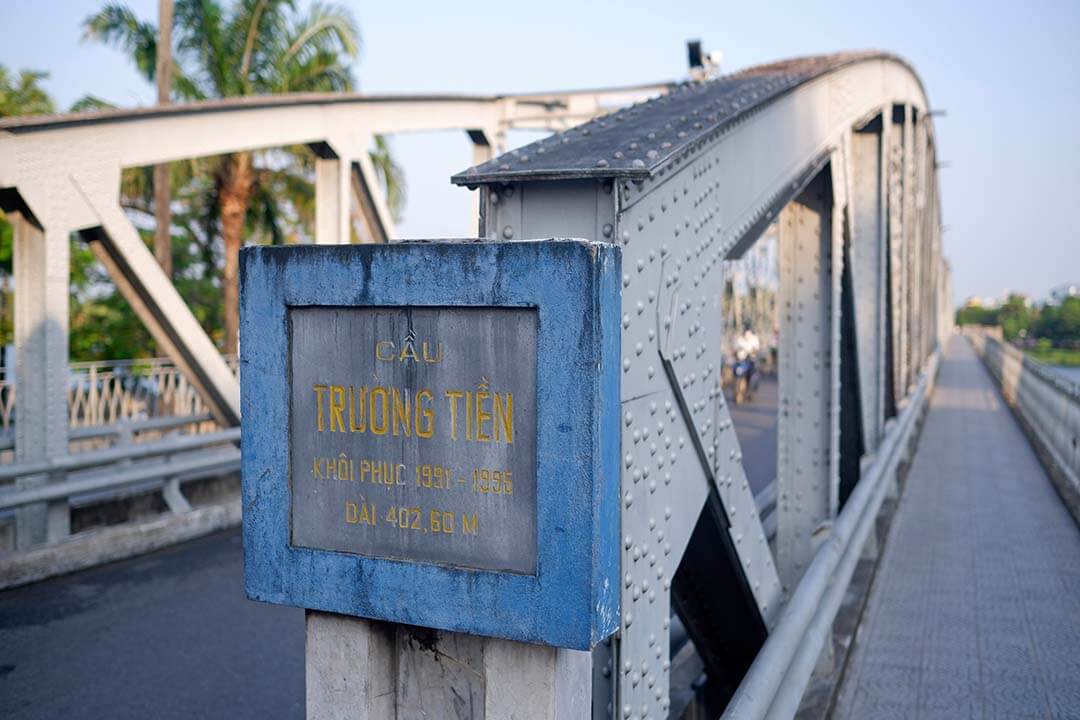
The bridge’s name changed several times, reflecting the turbulent history of Vietnam. In 1945, amidst the growing struggle for independence, it was renamed Nguyen Hoang Bridge, honoring a nobleman significant to the Thuan Hoa region. The bridge endured the ravages of war, suffering damage during the First Indochina War and the Vietnam War. After the war ended in 1975, it was restored and officially named Truong Tien Bridge, which endures today. In 2002, it was further enhanced with a colorful lighting system, making it a vibrant attraction during the Hue Festival. Now, the bridge stands as a resilient symbol of Hue, offering stunning views of the Perfume River, particularly when illuminated at night.
The location of Truong Tien Bridge
The bridge is a central and defining feature of Hue City, elegantly spanning the Perfume River and linking the city’s northern and southern regions. This strategic placement at the heart of Hue makes the bridge a vital transportation route and positions it as an integral part of the city’s daily life and historical identity. The bridge is surrounded by many of Hue’s most important landmarks, including the Imperial City, which lies just a short distance to the north. This proximity allows visitors to quickly traverse from the bustling heart of Hue’s modern cityscape to the former imperial capital’s tranquil and historically rich grounds.
On the southern side, Dong Ba Market – Hue’s largest and most vibrant market within easy reach of the bridge, offers a window into the daily lives of locals and the rich tapestry of Hue’s cultural heritage. The bridge’s central location makes it a natural conduit for exploring Hue, whether walking along the riverbanks, cycling through the city’s historic streets, or driving between its many attractions.
The view of the bridge provides a stunning perspective of the Perfume River, capturing the essence of Hue’s beauty and the harmonious blend of nature and architecture that defines the city. As a gateway to Hue’s rich cultural and historical offerings, the bridge is more than just a means of crossing the river; it symbolizes the city’s enduring connection to its past and its ongoing journey into the future.
The best time to visit Truong Tien Bridge
From September to November, autumn is the best time to visit the bridge. Hue is draped in the gentle embrace of its excellent and misty season. This period is marked by mild temperatures and a tranquil atmosphere that enhances the bridge’s charm. The Perfume River, over which the bridge spans, often becomes veiled in a soft mist during the early mornings and late afternoons, creating an almost ethereal scene that perfectly complements the historical ambience of Hue.
The combination of cooler weather and the city’s natural beauty at its peak offers visitors an idyllic setting to explore the bridge and its surroundings, making it a photographer’s dream and a peaceful retreat for those seeking to immerse themselves in the serene landscape of Hue.
I recommend that you read about the climate in Vietnam before visiting
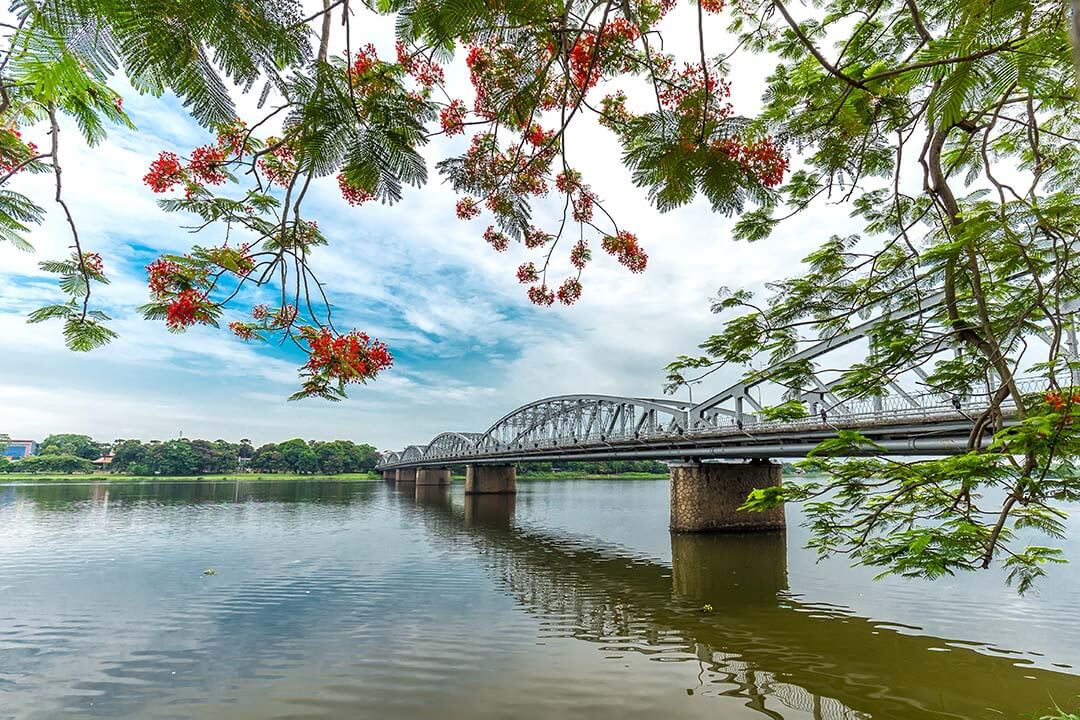
Another ideal time to visit is from May to July, coinciding with the blooming season of the flamboyant flowers, known locally as “hoa phượng vĩ.” These vibrant red flowers burst into full bloom, lining the banks of the Perfume River and adding a striking contrast to the bridge’s steel structure. The sight of the bridge framed by a canopy of fiery blossoms is breathtaking and offers a unique opportunity to experience Hue’s landscape at its most colorful.
Whether strolling across the bridge or capturing the vivid scenery, visiting during this season allows you to witness the bridge amidst one of Hue’s most vibrant natural displays. These times of year showcase the bridge’s beauty and provide an enriched experience of Hue’s cultural and natural heritage, making your visit truly memorable.
What should you do at Truong Tien Bridge?
The bridge offers a variety of experiences for visitors, making it a must-visit destination in Hue.
Stroll along the riverfront and pedestrian street
A stroll along the riverfront and pedestrian street adjacent to the bridge offers a delightful way to experience Hue’s vibrant atmosphere and picturesque scenery. The riverfront, with its expansive views of the Perfume River, provides a serene backdrop for leisurely walks. As you wander along the riverside path, you’ll be treated to panoramic vistas of the gently flowing water framed by lush greenery and traditional architecture. The river’s reflective surface, especially during the early morning or late afternoon, can create a stunning mirror image of the bridge and the city’s skyline, making it an ideal spot for photography and quiet contemplation.
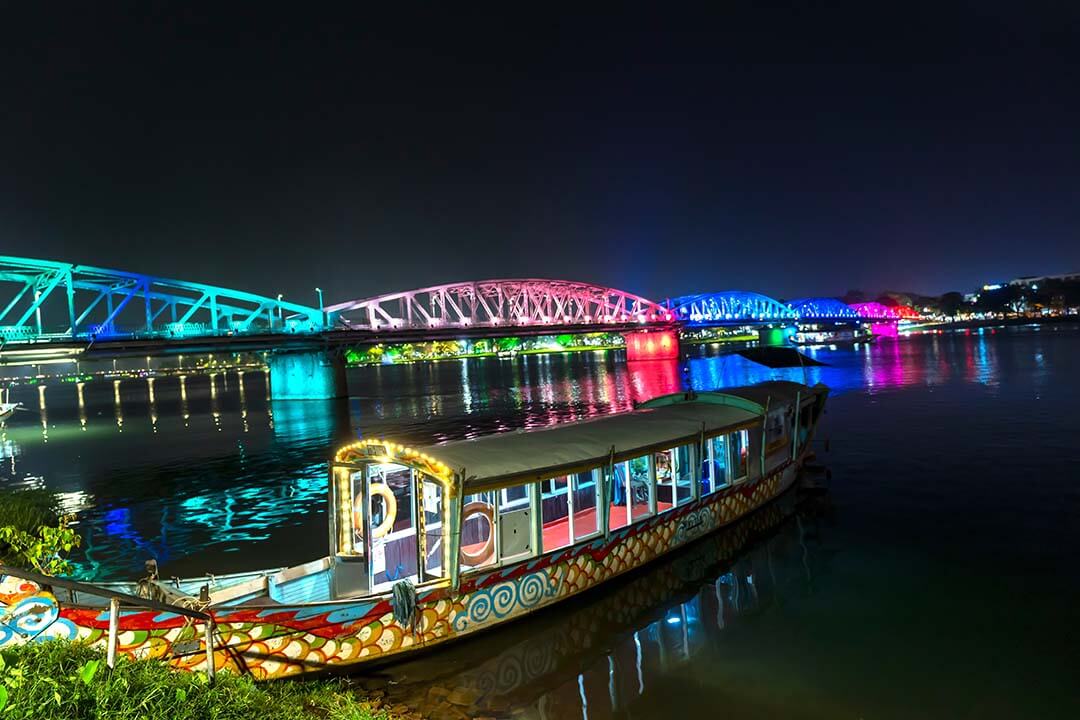
The adjacent pedestrian street adds a dynamic element to your visit. This bustling area is a hub of activity where locals and tourists converge to enjoy the lively atmosphere. Street vendors sell an array of local delicacies and souvenirs, giving you a taste of Hue’s culinary and cultural offerings. The pedestrian street has cafes and shops, providing ample opportunities to relax and soak in the surroundings. You might encounter street performers and local artisans as you explore, adding to the vibrant tapestry of experiences. This area is a perfect place to unwind and a gateway to deeper engagement with Hue’s rich cultural heritage and daily life, making your visit to Truong Tien Bridge a well-rounded and memorable experience.
Capture the essence of Hue
The bridge offers some of the best vantage points for capturing the essence of Hue, providing a unique perspective on the city’s blend of historic and natural beauty. From the bridge, you can enjoy sweeping views of the Perfume River as it meanders through the town, flanked by lush greenery and traditional architecture. The bridge is particularly striking at sunrise and sunset when the soft light casts a warm, enchanting glow over the landscape. At sunrise, the early morning mist and gentle light create a serene, almost ethereal atmosphere, perfect for capturing the peaceful start of the day.
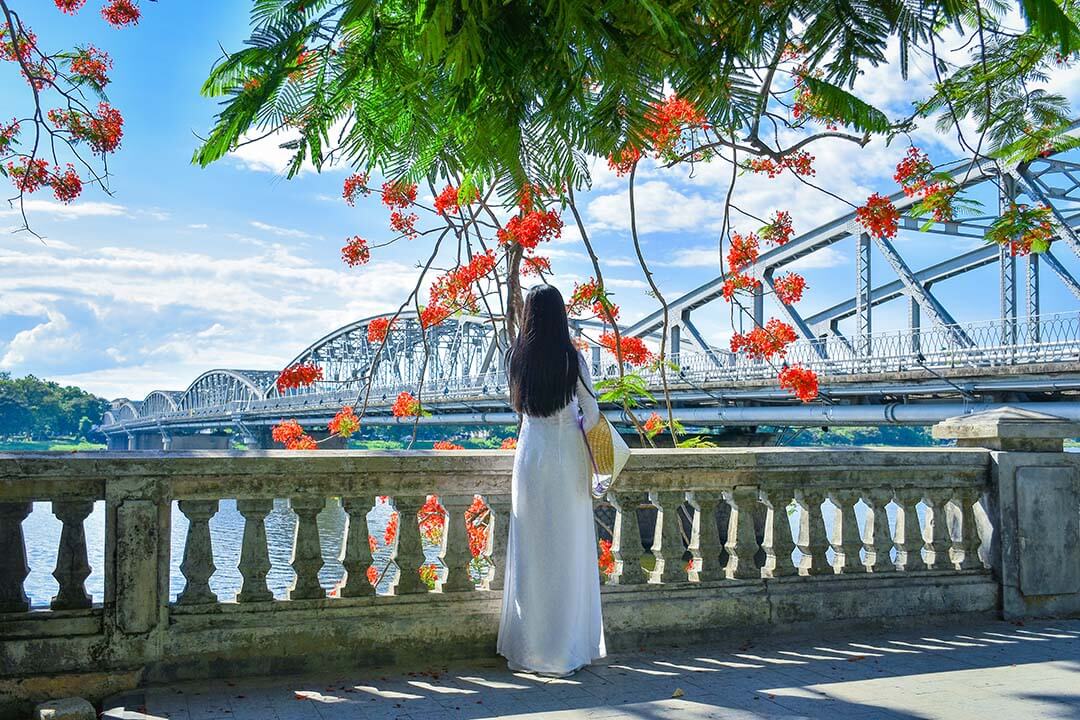
During sunset, the scene transforms as the sky fills with vibrant orange, pink, and purple hues, beautifully reflected in the river’s surface. This dramatic light contrasts the bridge’s steel structure and enhances the surrounding city’s details. Whether photographing the panoramic cityscape or focusing on the bridge’s intricate design, The bridge provides many opportunities to document Hue’s rich heritage and picturesque scenery. The views from the bridge offer a captivating reflection of the city’s timeless charm, making it an ideal spot for creating memorable and visually compelling images.
Enjoy the lively atmosphere at night
The bridge transforms into a vibrant spectacle at night, radiating with life and color. As darkness falls, the bridge is illuminated by a state-of-the-art lighting system that bathes its structure in a kaleidoscope of hues, creating a dynamic and enchanting visual display. The lights gracefully shift between red, blue, green, and purple shades, casting a mesmerising glow over the bridge and the Perfume River below. This ever-changing palette of colors reflects off the water’s surface, enhancing the river’s natural beauty and creating a captivating mirror effect that doubles the visual impact.
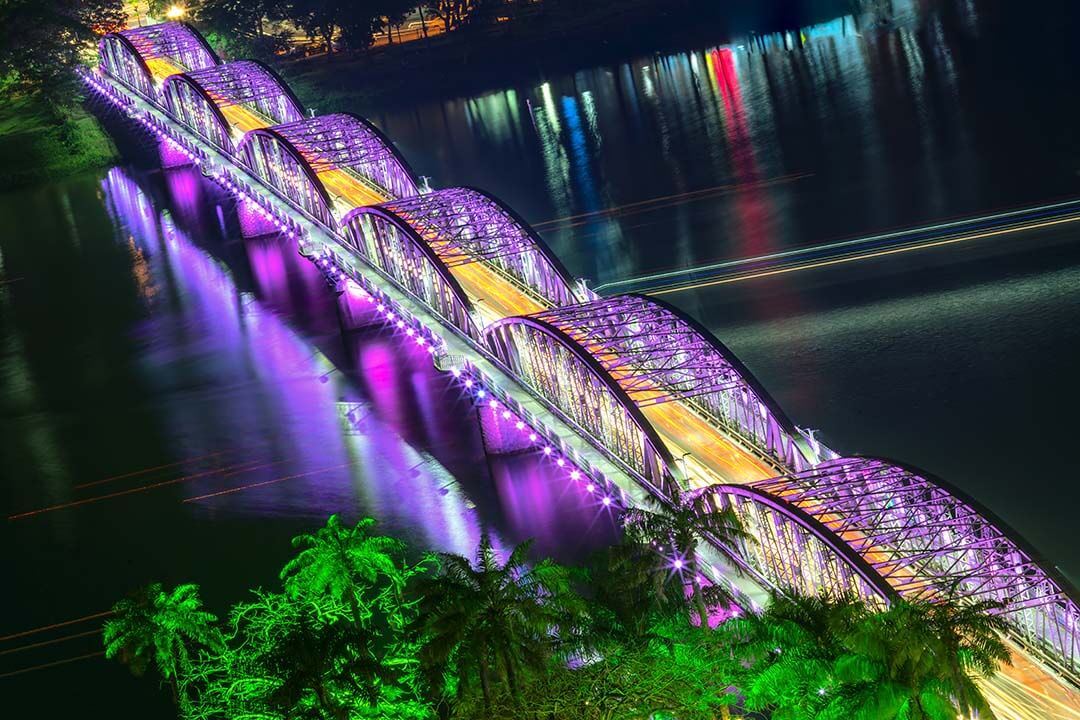
Walking across the bridge at night is an experience that fully immerses you in the magic of Hue. The vibrant lights and the cool evening breeze create excitement and serenity. The lively surroundings are often accompanied by the sounds of local life-distant chatter from nearby cafes, the occasional music from street performers, and the soft hum of traffic. This nocturnal setting provides a unique opportunity to witness Hue’s charm from a different perspective, as the bridge’s illumination highlights the city’s blend of historical elegance and modern vibrancy. Whether you’re taking a stroll or simply pausing to admire the view, the nighttime atmosphere of the bridge offers an unforgettable experience that showcases Hue’s allure and timeless beauty.
The most beautiful attractions near Trang Tien Bridge
Truong Tien Bridge is conveniently located near several of Hue’s most famous attractions, making it an excellent starting point for exploring the city.
Thien Mu Pagoda
Thien Mu Pagoda, also known as the Pagoda of the Celestial Lady, is one of Hue’s most iconic religious landmarks, perched on Ha Khe Hill along the Perfume River’s northern bank. The pagoda symbolises Hue’s rich spiritual and cultural heritage, with its seven-story Phuoc Duyen Tower serving as a lasting emblem of the city. Built-in 1601 during the Nguyen Dynasty, Thien Mu Pagoda is an architectural gem and a site rich in history and legend, making it a must-visit for those exploring Hue.
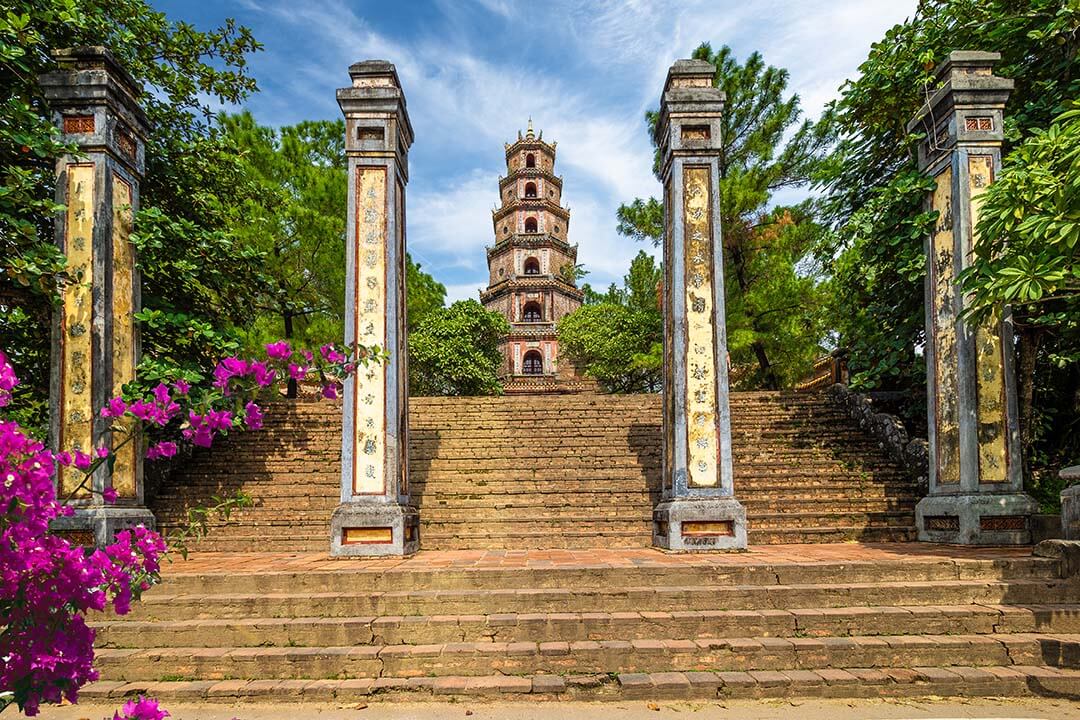
The pagoda’s elevated position offers stunning views of the Perfume River and its surroundings, creating a serene and picturesque setting. The Phuoc Duyen Tower, rising 21 meters high, greets visitors and is visible from many parts of the city. Each of its seven stories is dedicated to a different Buddha, showcasing the pagoda’s deep ties to Buddhist traditions. As you explore the grounds, you’ll find a blend of historical structures, ancient stone steles, and beautifully manicured gardens, all contributing to its tranquil atmosphere. Beyond its beauty, the pagoda has played a crucial role in Hue’s religious and political history. It serves as a place of worship and a symbol of resistance in vital moments of Vietnam’s past.
Hue Imperial City
The Hue Imperial City, a UNESCO World Heritage Site, offers visitors easy access to one of Vietnam’s most significant historical landmarks. Serving as Vietnam’s political, cultural, and religious centre during the Nguyen Dynasty from 1802 to 1945, the Imperial City spans over 500 hectares. This vast complex is a meticulously designed network of fortified walls, palaces, temples, courtyards, and gardens, reflecting the grandeur and sophistication of Vietnam’s last imperial era. The architecture and layout were inspired by Chinese imperial cities but infused with distinct Vietnamese elements, creating a unique and majestic atmosphere.
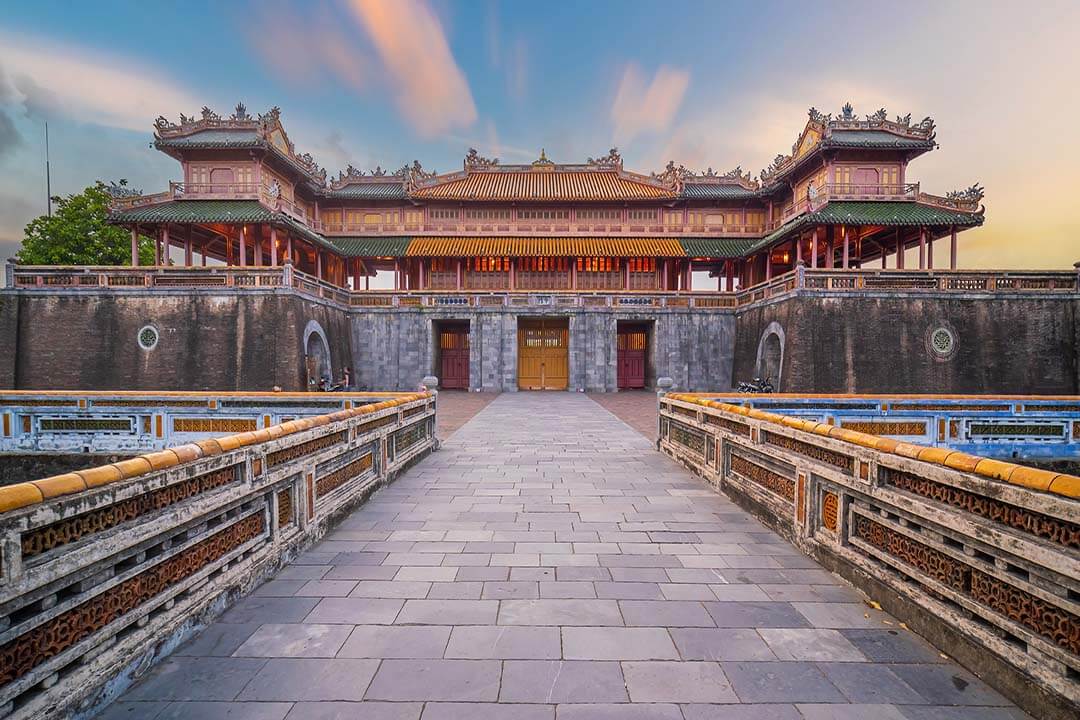
Exploring the Hue Imperial City offers a deep dive into Vietnam’s royal past. Key highlights include the Ngo Mon Gate, the grand entrance to the complex; the Thai Hoa Palace, where royal ceremonies were held; and the Forbidden Purple City, the emperor’s private residence. The site also features numerous temples and shrines dedicated to Confucianism, Buddhism, and the worship of royal ancestors, underscoring the complex’s spiritual significance.
The lush gardens, tranquil ponds, and detailed carvings throughout the Imperial City create a serene environment that allows visitors to fully immerse themselves in the rich history and cultural heritage of the Nguyen Dynasty. This historic site is a must-visit for anyone looking to experience the architectural beauty and historical depth of Vietnam’s imperial legacy.
Dong Ba Market
Dong Ba Market, located just a short distance from Truong Tien Bridge, is one of Hue’s most vibrant and essential cultural hubs. Established during the Nguyen Dynasty, this sprawling market has long been a cornerstone of daily life in Hue, offering visitors a glimpse into the local way of life. As the largest market in the city, Dong Ba covers multiple floors and sections, each bustling with activity from dawn until dusk.
The market is a sensory experience, with vendors selling everything from fresh produce, meats, and seafood to traditional Vietnamese herbs and spices, all contributing to the rich culinary heritage of Hue. The colorful array of fruits and vegetables, often displayed in beautifully arranged baskets, is a feast for the eyes. At the same time, the aromatic scent of street food wafts through the air, inviting visitors to sample the local delicacies.
Things you might be interested in:
- Try 26 best foods of Vietnamese in this article
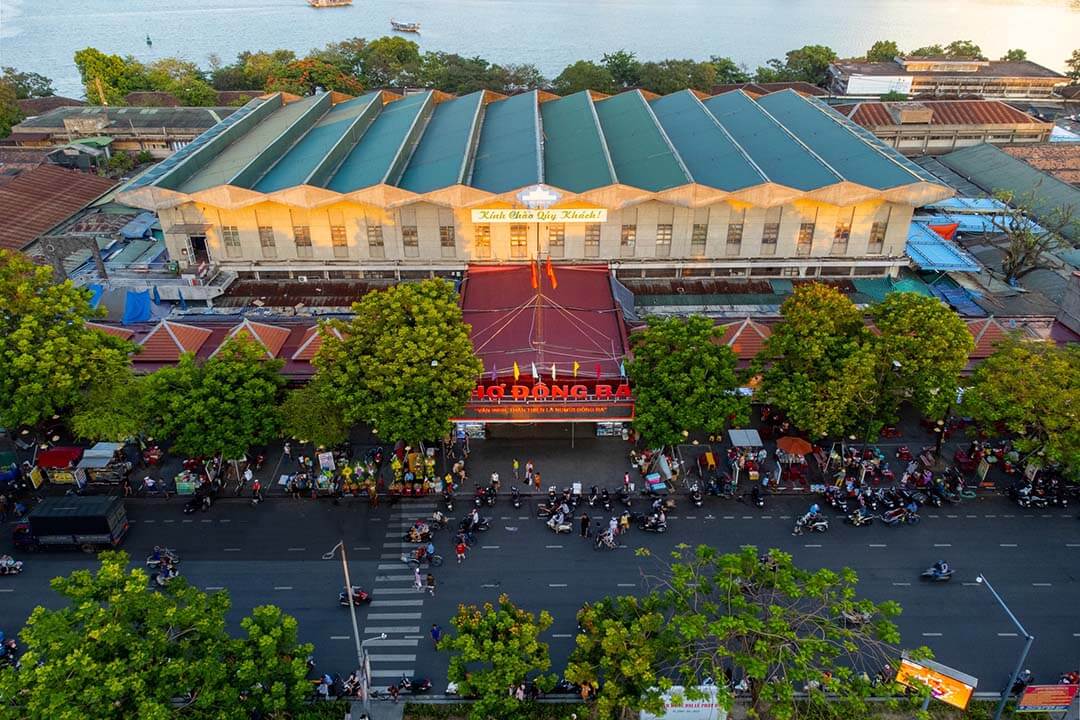
Beyond its food offerings, Dong Ba Market is a treasure trove of traditional handicrafts and souvenirs, making it an ideal spot for those looking to take home a piece of Hue’s culture. Shoppers can find intricately woven conical hats, known as nón lá, handmade textiles, ceramics, and other artisanal products that reflect the craftsmanship and artistry of the region.
The market is also a hub for traditional clothing, including the iconic Áo Dài, often tailored on-site for a perfect fit. Navigating the busy aisles of Dong Ba Market provides an authentic experience of the local culture, allowing visitors to interact with friendly vendors, haggle over prices, and immerse themselves in the everyday rhythms of Hue’s residents. Whether you’re there to shop, eat, or simply observe, Dong Ba Market offers a lively and enriching experience that captures the essence of life in Hue.
Truong Tien Bridge is more than just a crossing over the Perfume River; it symbolises Hue’s rich history, culture, and resilience. Whether you’re walking along its arches, capturing scenic views, or exploring nearby attractions, the bridge offers a unique window into the soul of Hue. For more travel insights and tips, including recommendations on when to visit and what to do, visit Vietnam Travel Tips blog, your ultimate guide to exploring Vietnam’s hidden gems.


